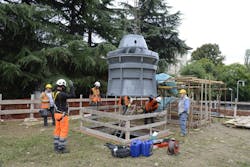Building an Invisible and Soundless Power Plant in Italy
The Canale Villoresi, located north of Milan, Italy, was designed for agricultural irrigation while providing water to the city of Milan. The paths running along the canal were used for recreational purposes and cross through some of the most beautiful natural parks in Lombardy. Later, European mandates required the reduction of water consumption by 30%, adversely impacting a region that benefits greatly from agriculture and farming income. Alessandro Folli, chairman of the Consortium of Reclamation Ticino Villoresi, recognized that the channel had not only become a tourist attraction, but also performed water management tasks while being an important source of power. As a result of these findings, a transformation of this canal into a multifunctional resource was set in motion, with the goal of ensuring the river would continue to be a sustainable resource economically as well as providing a reliable water irrigation supply for farmers.
Folli’s original intuition, under guidance of the consortium, was to utilize the water of Canale Villoresi to produce electricity by installing power plants. Five hydroelectric plants capable of producing 10 GWh, which equates to energy production for roughly six hundred apartments, were planned.
With the installation of these power plants came various challenges, including:
- Construction on an obstructed landscape;
- Construction that could only be conducted during winter months to enable ease of maintenance and cleaning tasks;
- Building a modern power plant inside a historical building with no modifications allowed to the architectural structure of the building;
- Regulations by the Italian Administration of Historical Buildings regarding allowable noise level and visual appearance; and
- Installing turbines in a residential area utilizing the original penstock/tailrace structure.
Assembling the generator to the hydraulic unit in one step, without any need of bearing or shaft alignment.
Solution
Submersible technology was determined be ideal for these requirements. Based upon Xylem’s extensive experience with the design and installation of submersible equipment, engineers Mario Fossati, Fulvio Bernabei and Davida Bavera, among other external consultants, requested Xylem’s expert assistance with this project.
In favor of the Xylem solutions, Bavera points out that the submersible electric generators were much less labor intensive to install due to their compact design. The units were laid on preassembled stands with three-phase asynchronous generators cooled by surrounding liquid. These features were beneficial in reducing the size of the hydroelectric power plant.
The PLC system will monitor the channel water levels upstream of the penstock; the automatic blade angle adjustment system will help maintain continuous power production, adjusting to the channel water level changes.
“The equipment performance is great,” explains Bavera, “Xylem supported us through our specialized installation, providing experienced technicians. Upon completion of the project, we received congratulations from the owners who appreciated the professionalism of the staff involved.”
Quick and easily installed Flygt submersible hydroturbine—invisible and silent for reliable and efficient operation.
Results
With the support of the Xylem team, the Consorzio Est Ticino Villoresi now has an integrated SCADA system in each of the new turbine plants with constant monitoring and remote operation. Reports are made available in real time, eliminating the need for periodic inspections.
“Thanks to the international state-of-the-art facilities and the collaborative relationship with Xylem, we have been able to complete a project with [a return on investment] in a much shorter time than usual with no visual impacts to our aesthetic region,” Folli said. “Our submerged power stations have become a another point of attraction for those who walk the banks of the canal.”
